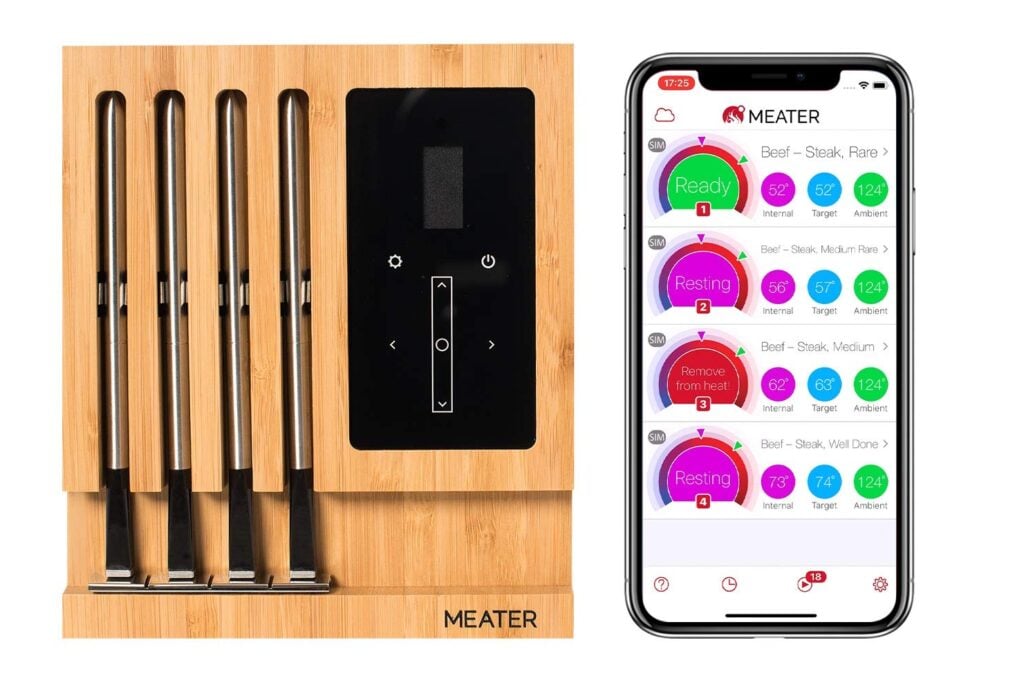YOU ARE HERE >> AmazingRibs » Ratings & Reviews » Ratings Reviews And Buying Guides » Best Thermometers For Food And Cooking » How to Buy the Best In-Food/In-Cooker Thermometer » Meater Block Food Thermometer Review And Rating
Meater Block Food Thermometer Review And Rating
All of our reviews are done independently by our team of testers and are in no way influenced by advertising or other monetary compensation from manufacturers. Click here to learn more about our unbiased product review process.
Published On: 9/13/2019 Last Modified: 11/6/2025

The Meater Block Food Thermometer from Apption Labs is the first of a new breed. While most competing products employ temperature probes tethered to a transmitter by a wire, the Meater is wireless. It builds the transmitter and battery to power it into the probe itself. This results in a truly wireless interface with a fairly large diameter probe with a narrower operating temp range.
Other Meater Food Thermometer Models
The Meater comes in several models. The most basic has a single probe that communicates directly with a smart phone using Bluetooth, and claims a range of 33 feet (10m). Next up in the lineup is the Meater+. This also has a single probe, but it includes a repeater that talks to the probe and your smart phone. The repeater has a claimed range of 165 feet (50m). The top of the line is the Meater Block, the unit we tested. This configuration comes with four probes and a charger/repeater that communicates with the probe via Bluetooth and relays data to the smart phone/cloud via Wi-Fi, using your router to connect. Range is not specified, but would probably be limited by the probe/block Bluetooth link. More on range later.
Charging
The probes are charged while inserted into their retaining slots in the wooden storage block while the block is powered off. According to the manufacturer, they should run for about 25 hours when fully charged. I set up a session that ran for over 25 hours, and the probe was still communicating with the block. Four AA batteries supply the charging current and the power to run the block itself. They are claimed to last for 50 hours of use, and that is consistent with my usage of the product. You can use a USB cable and power supply that will replace the batteries, but it will NOT charge the AA batteries in the block.

Temperature Readings
In normal operation, the app receives data from the probes via the cloud. There is also a mode where you can read the temps directly from the block itself without using a smart phone. The target temperature for each probe can be set independently. Alarms can be set to alert the user when the target temperature has been reached. There is also an optional five minute warning before the food will be ready. More on this prediction feature below.
The diameter of the probe is too large to allow it to fit into my usual accuracy testing instrument. To test accuracy, I placed the probe into water baths of known temperatures. I tested at 32°F, 130°F, and 208°F (0°, 56°, and 98°C). In all cases, the food probe was within a degree. The maximum temperature for the food end of the probe is 212°F (100°C). To test the ambient sensor, I placed the probe into a folded, wet cotton sock somewhat beyond the safety notch. This notch is the minimum depth into the food that will prevent thermal damage to the probe. I then inserted this “food” into an oven at 325°F. I monitored the oven temperature with another thermometer of known accuracy. The ambient sensor consistently read 40°F lower than the reference probe.
The Meater’s Temperature Prediction
The Meater attempts to provide a prediction of when the food will reach its target temperature. In my sock experiment above, the temperature of the food rose until it reached the stall, around 155°F, and then flattened out. The stall is a point well known when heating wet surfaces at which the evaporation cools the meat (or sock) at the same rate as the warm air heats it, and the internal temp stalls, refusing to rise until the surface dries out. Click here for more on the stall.
This behavior confused the prediction algorithm, resulting in ever longer estimates of the time to finish. I wouldn’t rely on it to tell me when a brisket or pork butt would be ready. (No one else has solved this problem either, as far as I know.) I tested the prediction algorithm while grilling a steak and it gave an accurate estimate of the time remaining. See the comments about thermal damage, below.
Probe Testing
As a radio frequency engineer, I was concerned about how effectively the probe could communicate with the block when it was placed inside a conductive enclosure. My first test was to place the probe inside a microwave oven, a device designed to contain radio waves. (No, I didn’t turn the oven on!) As expected, the probe lost contact with the block, but you would never use this thermometer in a microwave anyway. The next step was to test the communication between the probe and the block while it was in the oven I used to conduct the sock test. I used a Breville oven that is essentially a big toaster oven with a large glass window. In this case, I did not experience any problems communicating between the probe and the block.
The third test involved putting the probe inside a Weber Smokey Mountain smoker. This cooker is essentially an all-metal enclosure, although there is an insulating seal between the cooker barrel and the top that may have allowed the top to act as an antenna. In any case, I was able to maintain Bluetooth connectivity between the probe and the block for about 60′ (~20m). When I lost the connection, I got an aural and visual warning on my smart phone that I had lost contact with the device. The block itself had been configured to communicate with my home router/hotspot, and I had no communication problems between these two devices. With the cloud feature enabled, I would be able to monitor the Meater probes anywhere I had an internet connection.
Possible Concerns with the Meater Probe
Another area of concern was the susceptibility of the probe to thermal damage when grilling. The ambient temperature sensor – the ceramic end of the probe opposite the pointy end – is rated to 572°F (275°C). This section of the probe would be half the meat thickness above the grill grate, possibly subjecting the probe to very high temperatures, especially during a flare-up. (To be fair, some probes tethered via a stainless steel cable may not survive direct flames, either.) To test the durability of the probe I inserted it into a 2” (5cm) thick rib eye steak. I set up my grill for two-zone cooking and placed the steak over the unlit gas burner while providing heat from the other burner.
A reference probe showed the ambient temp to be about 275-325°F (135-163°C) and the Meater ambient reading was reasonably consistent with that. I monitored the food temp using the Meater and a reference probe and found the agreement between the two measurements to be very good, within a couple of degrees of one another. When the internal temp reached 115°F (46°C), I placed the food over the flame side and seared the meat on both sides, flipping the steak several times until the internal temp reached 130°F (54°C). During the searing process, there were several minor flare-ups, but the probe soldiered on without any problem or failure.
Using the App
You use the app to create a cooking session for each probe. You can select from pre-programmed doneness levels for various food types or select the target temp of your choice. The app provides a readout of the internal food temp, the target temp, and the ambient temp for each probe, as well as the time prediction mentioned above. You can display a temperature vs. time graph for the duration of the cooking session. However, once the target temp is reached, the cooking session terminates. This prevents the user from setting intermediate target temps that might be used for two-zone cooking, for example. You can also share the cook profile, but I was unable to make this work despite being connected to the cloud and monitoring the cook from miles away. The app could use a few tweaks, IMO.
Warranty
The Meater Block Food Thermometer’s warranty is one year. You can find contact info for the company in the instruction manual. Plus, their website has a lot of useful FAQs. I did not have occasion to contact customer support.
Our Review
Honestly, I have to admit that I was skeptical of this product’s technology. I didn’t think I’d be able to maintain radio connectivity between the probe and the block. I was afraid that heat would damage the probes. Neither suspicion was confirmed; the Meater passed my tests with flying colors. The longevity of the internal batteries is still an open question, but I don’t have any indication that that will be a problem in the long run. I am sending the unit to Meathead and he will do these tests.
Overall, the Meater Block Food Thermometer exceeded expectations. Its approach has already been copied by other manufacturers. (Product reviews coming soon!) Its build quality is good and the price is competitive. I recommend this product as an innovative entry into the wireless cooking marketplace.
The Meater Block Food Thermometer is now owned by Traeger. So, customer service issues that existed when they launched should now be a thing of the past.
Click the buttons below to search our complete database of reviews:
Product Information:
-
Thermometer Function:Leave in Food, Leave in Cooker, Wireless Remote
-
Item Price :168.00
*Price Subject To Change -
Where to buy: ** buying from one of these suppliers will help support this website.
-
Probe:(4) Diameter: 0.236" (6mm), length: 4" (10cm)
-
Battery Type:4xAA, included
-
Battery Life:50 hours
-
Safe Operating Range:up to 140°F
-
Min & Max Temp:Food: 212°F (100°C); Ambient: 527°F (275°C)
-
Display Precision:1°
-
Actual Temp at 32 Degrees:32
-
Actual Temp at 130 Degrees:130
-
Speed from 32 to 212 Degrees:n/a
-
Water Resistance Rating:Not waterproof
-
Weight:1.34 lb. (606g)
-
C/F Switch:Built in CF switch
-
Backlight:Built in Backlight
-
Color Options:Wood
-
App:iOS and Android
-
Included:Block, four probes, batteries, instructions
-
Available Accessories:Additional probes available
-
Alarms:Audible/Visible/Vibration
Manufacturer:
-
Meater/Apption Labs
Related reviews
- MeatStick X Wireless Food Thermometer Review
- Tappecue Touch And Airprobe2 Bundle Review
- Meater 2 Plus Review And Rating
-
Bill McGrath, AmazingRibs.com Chief Thermometer Reviewer - Bill McGrath is AmazingRibs.com's Thermometer Maven. He has sophisticated equipment, an electrical engineering degree from Cornell University, and an MBA (almost) from UC Berkeley.
Up Your BBQ IQ By Joining The Pitmaster Club

Sign up for a free trial of the AmazingRibs.com Pitmaster Club and experience everything that the world’s largest membership-based BBQ and grilling community has to offer!

High quality websites are expensive to run. If you help us, we’ll pay you back bigtime with an ad-free experience and a lot of freebies!
Millions come to AmazingRibs.com every month for high quality tested recipes, tips on technique, science, mythbusting, product reviews, and inspiration. But it is expensive to run a website with more than 2,000 pages and we don’t have a big corporate partner to subsidize us.
Our most important source of sustenance is people who join our Pitmaster Club. But please don’t think of it as a donation. Members get MANY great benefits. We block all third-party ads, we give members free ebooks, magazines, interviews, webinars, more recipes, a monthly sweepstakes with prizes worth up to $2,000, discounts on products, and best of all a community of like-minded cooks free of flame wars. Click below to see all the benefits, take a free 30 day trial, and help keep this site alive.
Post comments and questions below
1) Please try the search box at the top of every page before you ask for help.
2) Try to post your question to the appropriate page.
3) Tell us everything we need to know to help such as the type of cooker and thermometer. Dial thermometers are often off by as much as 50°F so if you are not using a good digital thermometer we probably can’t help you with time and temp questions. Please read this article about thermometers.
4) If you are a member of the Pitmaster Club, your comments login is probably different.
5) Posts with links in them may not appear immediately.
Moderators